
MAY CONTAIN NUTS

Search Shorpy
SHORPY ART

Framed or unframed, desk size to sofa size, printed by us in Arizona and Alabama since 2007. Explore now.
Join and Share
Ad-Free Shorpy
Shorpy is funded by you. Patreon contributors get an ad-free experience.
Learn more.

Recent comments
- Snazzy skirt
- Carbon Arc Lamps
- Illuminate us
- I remember it well
- I can't prove it
- Complicated then, forgotten now
- Bryan-Stevenson
- Skinny is as skinny does
- How do you rest in peace
- Riding the footboards
- Alas, hidden from view
- Baldwin Diesels
- Exclusive pump
- Bananas, Oysters and Smokey Joe
- Details, Details
- What's that building to the left of the tower?
- Coal Barges
- Bromo-Seltzer
- Inner harbor
- The Basin
- What a headache!
- Giant stepladder?
- Yeah, it was cold
- Love those coats
- Link & Pin Days Remnant
- Baldwin 62303
- Baldwin VO-1000
- Cold
- No expense spared
- Tough Guys
Member Photos
The Shorpy
Print Emporium
Print Emporium
Search Shorpy
Search results -- 30 results per page
- St. Augustine Light: 1936
- ... shore constructions, Cape Cod and along the coast from the Long Island Sound to Maine. The lighthouses are used no more but are left ... Posted by Dave - 04/13/2013 - 12:09pm -
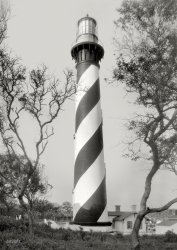
- Potter House: 1907
- ... died in 1864; James in 1879; William, president of the Long Island Railroad, in 1905; and, finally, Henry Jr., vice-president of the ... Posted by Dave - 07/29/2012 - 6:11pm -
![Potter House: 1907 Saginaw, Michigan, circa 1907. "Dr. Henry C. Potter's residence." 8x10 inch dry plate glass negative, Detroit Publishing Company. View full size.
The house knows how to accessorizeI love the windows and awnings. You don't see windows all dolled up like that anymore. Not on the outside anyway.
I'd live thereBut only if I could afford a housekeeper. And she better do windows, too.
Southern ExposureBefore air conditioning was common, south facing windows were often equipped with such shades.
TranquilityI look at this photo and say to myself, "The world has gotten too d@mn complicated." To sit on this porch in 1907 with a glass of lemonade and the evening paper, perhaps I would give up the comforts and technology of 2011. For back in 1907, if something had to be done or someone had to be contacted, it could just wait until tomorrow.
"Henry C. Potter"
Bathroom SuicideJan 5, 1909, N.Y. Times.
Dr. Potter's son:
HENRY C. POTTER Jr. A SUICIDE; Michigan Banker Was Suffering from Nervous Depression.
DETROIT, Mich., Jan. 4. -- Henry C. Potter, Jr., of the People's State Bank of this city, Secretary and Treasurer of the Flint Pere Marquette Railroad from 1884 to 1900, and a prominent figure in financial circles of Michigan, committed suicide to-day in the bathroom of his residence by shooting himself through the head.
A Wealthy ManAnd did he ever call his daughter's beau "That son of a Saginaw fisherman"?
Dr. Potter (1823-1909)Dr. Henry C. Potter's greatest accomplishment was the building and management of the Flint and Pere Marquette Railroad, which he undertook along with his father-in-law. He also formed and ran the Savings Bank of East Saginaw, from 1872 until the year of this photo. According to his biography in the "History of Saginaw County," "In his beautiful home, at Jefferson and Holland Avenues, he was a prince of hosts, courteous, hospitable, and ever thoughtful of the comfort and pleasure of his guests."
Voldemort IvyHe who shall not be named is creeping up the side of the house.
What's missing todayCraftmanship. The skill and artistry to produce intricate and quality wood products today is uncommon and we are the poorer for it.
Henry Camp Potter 1823-1909Born at Utica, New York, on January 14, 1823; died at San Ysidro Ranch near Santa Barbara on April 3, 1909, three months after his son Henry Jr. committed suicide.
He had led a full and interesting life, counting among his friends newspaper editor Horace Greeley, US Secretaries of State William H. Seward and James G. Blaine, and poet John Greenleaf Whittier. Before he died, he was one of the last remaining people to have heard Daniel Webster speak. Although he was a physician, getting his MD degree from Albany Medical College in 1844, Dr. Potter practiced medicine less than ten years. In 1852, he went into the public works construction business with his father-in-law, Samuel Farwell. That connection brought him to Saginaw in 1859 where he oversaw the building of the Flint and Pere Marquette Railroad. Dr. Potter served as treasurer, general manager and vice-president of that railroad until his retirement in 1891. In addition, he was instrumental in establishing the first salt company in the area, served on various bank boards and was conspicuously active in Saginaw civic affairs.
Dr. Potter was 86 when he died, old enough to have survived his wife of nearly 59 years, Sarah, and all four of their children. Helen died in 1864; James in 1879; William, president of the Long Island Railroad, in 1905; and, finally, Henry Jr., vice-president of the People’s State Bank of Detroit, by his own hand in 1909. It was said that last death likely did much to hasten Dr. Potter’s end.
1404 S. Jefferson Ave.This is 1404 S. Jefferson Ave near the corner of Jefferson and Holland. This entire block no longer exists today.
Watch your buggy step pleaseBetween the two hitching posts near the front porch is a square stone buggy step. They still survive here and there when not in the way such as mow strips between a sidewalk and the street.
[Also called "mounting blocks." - Dave]
(The Gallery, DPC, Railroads)](https://www.shorpy.com/files/images/4a22424a.thumbnail.jpg)
- Wet Beer: 1948
- ... Patchogue is now the sole Anheuser-Busch distributor for Long Island. Currently run by Clare's grand-children, the company recently ... Posted by Dave - 03/20/2015 - 8:50am -
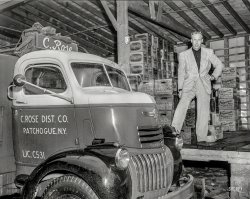
- Chair Car: 1922
- ... early 1930s that came off a hill and got hit by a car on Long Island. I bounced six times and was OK but the wagon was a fatality. The ... Posted by Dave - 02/21/2014 - 10:02pm -
![Chair Car: 1922 January 1922. Washington, D.C. "Man in three-wheeled vehicle." Which is, according to the nameplate, a ____G CAR. 4x5 glass negative. View full size.
BeautifulWall sconces and wall embellishments, so typical in the 20's! All would be gone by the 40's, replaced by bland industrial looking light fixtures and plain blonde walls.
Custer Chair Car?The vehicle looks a lot like the Custer Chair Car, featured on the very informative blog called Just A Car Guy, which concerns all things transportation-related.
[It could be -- both are made by a "Specialty Co." -- although our chair-car has a G in the name. - Dave]
The Segway of its eraJust need to find enough room to do U-turns. Fairly easy in hotel lobbies, but hallways? Concept good, execution needs work.
[Next stop, Walmart. - Dave]
Last standIt certainly does appear to be a Custer Car. A close-up of the rear hub on a similar photo appears to show the embossed legend "CUSTER CAR".
The inventor, Levitt Luzern Custer, filed a 1919 design patent for a very similar-looking "juvenile automobile." (It's obviously not the same design, but the resemblance is clear.)
[Two "juvenile" Custer Cars can be seen here and here on Shorpy. - Dave]
The Wheels!About 60 years ago I had an old red wagon from the early 1930s that came off a hill and got hit by a car on Long Island. I bounced six times and was OK but the wagon was a fatality. The wheels were smaller than those in this photograph but I remember the style and inside the black rubber was all "fire engine red".
StairdownI'm sure that vehicle was quite practical given the abundance of wheelchair ramps in 1922.
Tare weightI bet that thing weighs a ton (short, long or figurative.)
Restored Custer CarVideo linked from this blog.
Demon of the RoadsThe driver is none other than L. Luzern Custer himself, piloting what the caption describes as a "Cootie Car." (Washington Post, Jan. 21, 1922)
Although another clipping (The Daily Ardmoreite, 17 Nov. 1920) describes a different vehicle, a toy electric car for children similar to the ones here and here, as a Cootie Car:
(Technology, The Gallery, Cars, Trucks, Buses, D.C., Harris + Ewing)](https://www.shorpy.com/files/images/SHORPY_41899a.thumbnail.jpg)
- Space Cowboy: 1963
- ... research laboratories at Republic Aviation in Farmingdale, Long Island, N.Y." United Press International Telephoto. View full size.
... Posted by Dave - 06/10/2019 - 2:47pm -
![Space Cowboy: 1963 June 13, 1963. "Nonchalantly slurping his Earth-made ice cream cone, 5-year-old David Rowan appears awed with the eerie surroundings before him. The youngster was visiting the moon-like landscape of the space research laboratories at Republic Aviation in Farmingdale, Long Island, N.Y." United Press International Telephoto. View full size.
GraduationI graduated from high school on this date. Did not get an ice cream cone.
Good chance he's still with us.This kid may still be out there somewhere, he's only a year or two older than I am, it would be cool if he found this and commented.
Striped shirtsBetween 1957 and 1963, every boy under the age of 8 had at least two T-shirts just like this one. I know I did!
NopeAs someone who's six years older than Mr. Rowan I'm here to say he's probably dead.
[So you're saying that people who are 60 years old are "probably dead." - Dave]
Yes, but satirically (and a little indignantly) in response to Vintagetv's ominous "still with us" comment.
Lost In SpaceWhile eating an ice cream! Every boy's dream.
That gunfighter stanceEyes locked on his opponent. Shootin' arm casually held at ready. Easy on his feet. No fear. Then he says, "Well, are you gonna pull them pistols or whistle Dixie -- "
Maurice?... do some people call him that?
To Serve and ProtectHe has that six-shooter ready just waiting to protect that Rainbow ice cream cone.
What a revelation!The set where they actually staged the moon landing! What daring journalism from Shorpy!
Glad to see he's well armedas was I at that time -- we are the same age. Every self-respecting young cowpoke of the era was prepared to encounter Black Bart or the Creature from the Black Lagoon ... or the moon.
That's one small step for a boy ...Well, you know the rest.
Armed, Striped, No DairyIn 1958, the "Boys In Stripes" rule was already in effect, though the sidearms may have been optional.
The criminal element in Pascagoula, Mississippi, knew not to trifle with a fellow sporting twin Fanner Fifties.
(The Gallery, Aviation, Kids, News Photo Archive)](https://www.shorpy.com/files/images/SHORPY-59785u.thumbnail.jpg)
- Scrambling for Pennies: 1911
- ... creepy!
Little Beggars When I was growing up on Long Island (1950s) we would dress as "hobos" and go door to door begging ... Posted by Dave - 09/11/2011 - 8:35pm -
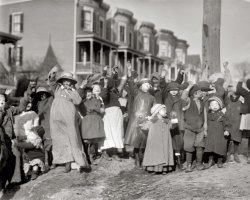
- V: 1942
- ... images, flashing the V for Victory sign.
LIRR The Long Island Railroad also uses Penn Station as its NYC terminus. At he time ... Posted by Dave - 09/05/2012 - 7:10pm -
![V: 1942 August 1942. "Crowds at Pennsylvania Station, New York." Medium format negative by Marjory Collins for the Office of War Information. View full size.
Sentimental JourneyAlthough it is apparent that all the men in uniform have an appointed destination and mission to accomplish, one has to wonder where all the other people are headed with children and cardboard suitcases. There seems to be no business men getting on these trains as one would see at Grand Central Station. I was in a similar line with my mother at the same place just one year later when my grandmother died in Pennsylvania and we took the night train to get there, my first experience as a youngster with a family death. Quite unforgettable.
V for Victory, and moreThe “V for Victory” banner dominating the background includes, as you see, the Morse code for the letter: three dots and a dash. Early in WW II the letter began to be used as a rallying signal, expressed by holding up one’s first two fingers with the intent of showing defiance to the Nazis. The BBC took this idea and created its V for Victory campaign, which continued through the war and essentially was used by all Allied nations and their armed forces. Mass communication then, obviously, was by radio, and the BBC gave a sound to the campaign for its broadcasts into occupied Europe by using the opening notes of Beethoven’s Fifth Symphony. I have no idea if this choice was some wry British humor or what, but Beethoven, of course, was a German.
[It was used because the opening notes of Beethoven's Fifth are three short notes and a long (da-da-da-daaaa), which corresponds to the Morse code for the letter V. -tterrace] [Ahem. That's what I thought I was saying in my first sentence, but I forgot to include the part about the notes.]
As a very young child during the war I traveled through Penn Station quite often and remember two details: the hundreds of model airplanes hanging from the ceiling (black Bakelight plastic aircraft recognition models, identical to a few I had at home) and the crowds of troops arriving and departing, as this photo illustrates. To this day I wonder about the fate of that uniformed generation of Americans that I saw; for some it had to be their last few steps on home soil.
Next weekend my wife and I will be in Penn Station en route to a place without question much nicer than the destination of many of the military men and women who visited there, all those years ago.
glass tileThat glass tile floor provided light to the tracks below. You can still see some portions of it looking up at the ceiling of the NJ Transit tracks.
Vault LightsNote the glass prism vault lights imbedded in the floor, which were used to illuminate the room underneath. As a kid I remember seeing these in San Francisco, but I think most large cities had them. There's an interesting web site that tell the full story at:
http://glassian.org/Prism/Vault/index.html
You could make millions!Every person in this photo could have become a millionaire if only he or she had the sudden thought: "Hey! Why not build wheels into these suitcases?"
Dinner in the DinerBack in the 1980s, I belonged to a singing group that performed for many "snow birds" in the Phoenix area. One of the favorite songs of our audiences was "Chattanooga Choo Choo", which includes the lyrics:
"You'll leave the Pennsylvania station 'bout a quarter to four, read a magazine and then you're in Baltimore, dinner in the diner, nothing could be finer, than to have your ham and eggs in Carolina"
As one of the oldest in the group, I had to explain what it meant, and keep reminding the other ladies that it wasn't "dinner AT the diner"! I was the only one who could remember dining cars on trains. In the early to mid 1960s, at 9 and 10 years old, I really didn't think much COULD be finer than dinner in the diner, during a cross-country train trip!
On a more serious note, I would love to be able to hear what experiences each person in this photo was having, that day, and in the next few years. Certainly, everyone in it was affected by the global war in some manner.
He's not ordering two more Pimm's CupsHere's Winston Churchill in one of his iconic images, flashing the V for Victory sign.
LIRRThe Long Island Railroad also uses Penn Station as its NYC terminus. At he time this picture was taken it was the best route to that Shorpy favorite, The Rockaways, on the Queens County Shoreline. After a 1950 fire on the tracks running across Jamaica Bay, in Broad Channel, the LIRR felt that the line was too costly to operate and they sold it to NYC and in 1956 it became the IND Subway System's Rockaway line. That opened up those great beaches to the rest of the city.
(The Gallery, Marjory Collins, NYC, Railroads, WW2)](https://www.shorpy.com/files/images/SHORPY_8d21791u.thumbnail.jpg)
- Signal Corps Library: 1943
- ... Kasserine Pass on Feb. 26 and 27. Because the SCPC was in Long Island City (at Astoria Studios), that probably matches the date range of ... I learned that the Signal Corps Library must be located in Long Island City, New York.
(ShorpyBlog, Member Gallery) ... Posted by John.Debold - 04/30/2016 - 12:27pm -
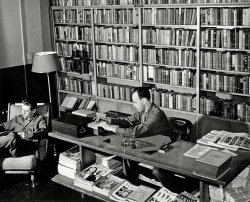
- Aero Mail: 1918
- ... of the journey from Philadelphia to Belmont field, in the Long Island suburbs of New York should be made in about an hour. The large ... Posted by Dave - 08/22/2012 - 8:38pm -
![Aero Mail: 1918 "Inauguration of Aero Mail service. Polo Field mechanics." On May 15, 1918, "America's first aerial mail service was put into operation when aeroplanes piloted by Army aviators carried consignments of mail from New York and Philadelphia to Washington, and from Philadelphia to New York." View full size.
Jenny Was No LadyLooks like a Hisso-powered Curtiss Jenny (JN-4H). If you recall, there are some really rare air mail stamps out there with an upside-down Jenny printed on them - that would be this plane.
http://www.ancientalley.com/ancient/rhinebck/jenny/jenny1.htm
Rare version of a classicThis is a Curtiss JN-4H "Jenny," widely used in pilot training. What makes this picture unusual is the Jenny's engine, a 150 hp Hispano-Suiza, the same type used in Eddie Rickenbacker's famous Spad fighter plane of the Lafayette Escadrille. The much more common JN-4D Jennys used the underpowered 90 hp Curtiss OX-5, with its Rube Goldberg open-air rocker arm assembly, unlike the modern Hispano-Suiza's smooth valve covers seen here.
The 150 hp JN-4H was quite the hot rod for its time and is fairly rare compared to the rank-and-file JN-4D. Incidentally, it's considered bad form to hang on the propeller, these things can have a "hot magneto" and start at any time.
George Clooney, is that you?Between the guy on the left with his fly undone and the one in the middle who's still too young to shave.
Almost as Safe as an Auto
Mail Air Line is Ready
Puts Locomotion Now Familiar to a New Use for People.
With the establishment of a regular aeroplane mail service between Washington and New York on Wednesday, the Postoffice Department considers that the project is experimental only in a sense that a means of locomotion now familiar is to be put to a new use. The war has demonstrated effectively that the aeroplane as a conveyance is almost as dependable and safe as an automobile, so the only real obstacle in the way of successfully operating the new air lines lies in the maintaining service under all kinds of weather conditions.
Twelve large training planes, each capable of making a maximum speed of 90 miles an hours, have been furnished by the War Department, to be used in the new service. The planes are one-seaters, as to maximum of space is desired in the fuselage for the storing of mail bags. They are built along the lines of the regulation bombing machines.
These planes are now being assembled in Mineola, N.Y. Three will be station in New York, six in Philadelphia, and three in Washington. Those for Washington will be shipped here either today or tomorrow.
Aviators for the service have been detailed from the ranks of the fighting airmen, in that War Department officials believe that the fliers will acquire valuable training in piloting the big mail aeroplanes over the long cross-country flights.
The schedule provides for the departure of one plane each day from this city and New York. The machines will leave at 11:30 o'clock in the morning and it is hoped to have the mail deposited at the other end not more than three hours later. Starting from the aviation field in Potomac Park, the trip to Philadelphia, about 135 miles, is expected to be made in about an hour and twenty minutes. At the hangers in North Philadelphia another machine will be waiting, ready to start the flight to New York as soon as the incoming plane lands and the transfer of mail bags has been made. The second leg of the journey from Philadelphia to Belmont field, in the Long Island suburbs of New York should be made in about an hour. The large planes are equipped to carry 600 pounds of mail or approximately 24,000 letters. The smaller machines will carry about half that amount.
Emergency landing fields have been established at Baltimore and Havre de Grace, Md., Wilmington Del., and New Brunswick, N.J. In the event of a machine breaking down at some interurban point in its journey, the mail sacks will be rushed by motor truck to the nearest railroad station, where they will be sent forward in care of a courier.
...
[Article continues with discussion of air mail stamps]
Washington Post, May 13, 1918
Wutta Prop JobNote the beautiful varnish finish on the propeller. Usually, that's all that's left of these machines today, since the finish preserves the wood so well. The same can't be said for the fabric. You can find any number of prop blades of similar vintage in antique shops across Cape Cod.
Intrepid aviatorsThe rate of fatalities among these early service pilots is chilling. The mail had to get through and brave pilots like these did their utmost to accomplish the mission. They pushed weather to the extreme limit and often paid with their lives. Every early mail pilot is a HERO!
Inauspicious BeginningsThose mechanics needed to be spending a bit more time checking out the aircraft and less time posing for photos. The following account of inaugural flight mishaps is from 2009 book Flying Across America: The Airline Passenger Experience by Daniel L. Rust.
Employing U.S. Army pilots, the service began on May 15, 1918, from the Washington, D.C., polo grounds. An array of dignitaries, including President Woodrow Wilson, attended the event. They witnessed Lieutenant George L. Boyle climb into the cockpit ready for flight, only to discover that the plane's engine refused to start. Minutes passed before someone checked the gas tank — it was empty. The crowd laughed as mechanics scrambled to fill the tank. At last, Boyle took off, bound for Philadelphia. But he mistakenly flew around, rather than past, Chesapeake Bay, away from this destination. Upon landing 24 miles way from the starting point, Boyle's craft flipped over, and the mail was transferred to a train for transport to Philadelphia.
The Army flew the mail again...in the spring of 1934, when negotiations between the Post Office Department and private air carriers broke down.
Again, considerable lives and aircraft were lost because AAC pilots didn't have the training or equipment required to meet constantly changing conditions and urgent schedules. Hap Arnold, then a lieutenant colonel in command of the western sector, admitted weather forecasts were essentially worthless to his fliers.
Maurer Maurer, an Air Force historian, wrote much about the mail flights of 1934 in his book Aviation in the U.S. Army, an amazing resource for the interwar era of military flight. They did much with little in those days.
(The Gallery, Aviation, D.C., Harris + Ewing)](https://www.shorpy.com/files/images/10831a.thumbnail.jpg)
- Triboro TB: 1940
- ... penchant for closing hospitals left and right (Brooklyn's Long Island College Hospital got the ax just the other day), Triboro Hospital ... Posted by Dave - 07/20/2013 - 6:42pm -
![Triboro TB: 1940 December 23, 1940. "Triboro Hospital for Tuberculosis. Parsons Boulevard, Jamaica, Queens. Typical six-bed ward, to balcony. Eggers & Higgins, architect." Large-format negative by Gottscho-Schleisner. View full size.
Ship ShapeI had always heard this hospital started life as a Naval Hospital, as in a forerunner of the VA system, and that's why it's shaped like a battleship. SS Tuberculosis?
Floor TilesWow, for a brand new hospital I can't believe how those floor tiles make it look like it's been there for a hundred years already!
Matron would never approveMatron would never approve of those lumpy-bumpy beds. All beds must be made to within an inch of their lives, preferably with straight edges and flat surfaces that would put a set of mathematical instruments to shame.
Even in this day and age of lax standards, beds must be made with precision and care, and even I have sent care staff back into rooms to remake beds that fail to meet standards of either cleanliness or visual appeal. Of course, in these times the alternating pressure air mattresses in wide use make the snappy hospital corners a difficult thing to achieve, but it still can be done.
Brand newThe hospital opened in 1940, so it's brand new in this picture. Quite possibly this ward had yet to admit its first patient. Somewhat surprisingly, given NYC's penchant for closing hospitals left and right (Brooklyn's Long Island College Hospital got the ax just the other day), Triboro Hospital is still there, though of course it's no longer a tuberculosis facility. It's now a currently-vacant part of Queens Hospital Center.
NYC's biggest tuberculosis hospital by far, in fact it was the biggest in the world, was Seaview Hospital on Staten Island. Built over a period of about 25 years starting shortly before World War I, at its peak it housed thousands of patients in more than twenty buildings. It even had the world's only maternity ward in a tuberculosis hospital (how's that for a cheery thought?)
Seaview was shut down in the early 1960's, though some of the newer buildings were converted into a still-extant rehabilitation facility. Several of the old buildings still remain in extremely decrepit condition, in fact they are so decrepit as to deter all but the most intrepid and/or foolhardy urban explorers. Here's a photo and video gallery from a recent exploration:
http://nyulocal.com/city/2012/02/24/exploring-staten-islands-abandoned-s...
Now-vacating T-BuildingThis building is currently known as the "T-Building" of the former Queens Medical Center, now part of the Queens Hospital Center. The lengthy balconies, running most of the length of its southern side on seven levels, and rounded ends, give it distinctive character. QHC board minutes show that the few remaining operations there are being relocated. According to a January 2013 story in the Queens Times-Ledger, a proposal is pending to convert it into a residential facility for low-income patients with chronic illnesses. There is, as they say, neighborhood opposition. See article here.
You - Outside the Door!Move to the middle, you're throwing off the symmetry!
Depressing placeTB wards are very depressing structures, more so when one considers that until the late 1960s, we didn't have a real way to treat TB. Meaning that when someone went to a place like this, it wasn't to be cured or get better. It was to simply die.
[Effective treatments, including cures, for TB date to the development of antibiotics in the 1940s, not 1960s. Most TB infections are asymptomatic; for active cases requiring hospitalization before the antibiotic era, mortality was around 50 percent. - Dave]
What makes it worse is the practices of the day for dealing with the deceased. Once a person passed away from the illness, every possession in their room which they came in contact with was incinerated. This was done because at the time they did not know how the illness was transmitted. What makes it worse, is that in most every TB hospital, there was also a crematorium. So the bodies were also burned. Once again, it is due to the fact that they didn't know how the illness was transmitted.
Large TB wards, like Waverly, had their own crematoriums on site; with several retorts to handle the sheer number of deaths. Others would contract it out to funeral homes or in some cases press the hospital's own incinerator into use.
(The Gallery, Gottscho-Schleisner, Medicine)](https://www.shorpy.com/files/images/SHORPY_5a06088u.thumbnail.jpg)
- Port O Call: 1940
- ... belt." (Hawk777)
My father, born in 1936, grew up on Long Island. Doing the math, he was 15 in 1951 and is now 75. To this day, he ... Posted by Dave - 01/15/2012 - 9:28am -
![Port O Call: 1940 August 1940. "Souvenir shop, Provincetown, Massachusetts." 35mm negative by Edwin Rosskam for the Farm Security Administration. View full size.
QuirkOdd way for someone to wear his belt. Was this common back then?
[It was the style of the day. - Dave]
Time Travel Hunting & GatheringI'd love to have that shiny modernist pitcher (whatever it reflects) for sale in my showcase at the antique mall right now, along with several other of the Port O' Call's then-humble souvenirs: the pair of stylized horses, the frosted-glass art moderne Jesus(?), and, in the left window, the crystal ball. They'd make a composition of distinction, even if they didn't sell right away.
How much is that pitcher in the window?It appears that the camera caught the young gentleman right after lighting his pipe and letting out a puff of tobacco smoke. More interesting, is the shiny pitcher in the window three shelves up. I zoomed in as close as possible to use the reflection in it as we did the Christmas tree ornaments. Across the street, it seems to split into two roads, with a building in the center. Alternatively, perhaps a stone wall to shelter a large home with large black metal gates in the center. I'm wondering if anyone has a magic program for closer inspection. And yes, I do have better things to do, but sometimes Shorpy can be addicting.
[From the full-size LOC tiff.]
In a hurryThis is exactly the kind of bric-a-brac store that I would walk quickly past and pretend I did not see, if I were on vacation with my wife.
The beltYes, style of the day. Auto mechanics and gas station attendants (remember them) would wear their belt buckles on the side to prevent scratching a car as they leaned over it while washing the windshield.
The Sideways Belt Buckle!Great photo!
Some guitar players still wear belts that way, so the buckle won't scrape against the backside of a nice guitar.
You'll see used guitars sold that are in great shape except for "slight belt-buckle rash" on the back.
--Jim
Currently for sale79 Commercial Street is currently for sale for $1,795,000. Other than that the front of this building still looks the same, minus the pitcher & bric-a-brac.
Ponte Vecchio of the CapeAs lindbergh previously noted, not much has changed after 72 years. The following description, from 1919, portrays a Commercial Street hardly different than today.
Motor Travel, 1919.
Over the Highways to Windmill Land.
A Trip to Old Cape Cod.
Florence M. Pettee.
…
The one street, as narrow as those of Venice, is edged with quaint houses, closely huddled, between which curious boats poke their interested noses. Hotel and humble fisher-cottage jostle pier and fruit-stand. This commercial street is the Ponte Vecchio of the Cape with its ever-present souvenir shops and food-purveyors. The running-boards nearly scratch the sidewalks, and passing another car has to be charted in advance. Wary pedestrians dodge hither and yon.
Still all the rage (for at least one)"Odd way for someone to wear his belt." (Hawk777)
My father, born in 1936, grew up on Long Island. Doing the math, he was 15 in 1951 and is now 75. To this day, he still wears his belt with the buckle approximately 45º to port.
When I asked about it when I was a kid (born in '62), he replied that when he was in his teens and 20s it was the style in the New York area, mostly for young single guys he thought. He liked it and never dropped it.
BeltbuckleMy husband still wears his belt like this.
The belt, the pitcher, and other thingsFirst, the belt -- very cool look in those days, but also practical. Back in the 1970s, my husband also wore his buckle to the side because he was both an auto mechanic and a bass guitar player. So there.
I love the pitcher -- in fact, I love lots of things in the window -- but most of all, I think, I love the Don Quixote figurine thing in the extreme upper left window. Ceramic maybe? -- can't tell -- but I wish I could hold it in my hands right now.
(The Gallery, Edwin Rosskam, Stores & Markets)](https://www.shorpy.com/files/images/SHORPY_8a15405a.thumbnail.jpg)
- A Boy and His Dog: 1904
- 1904. "Boy with dog." Oceanside, Long Island. 8x10 dry plate glass negative by the pioneering portrait ... Posted by Dave - 07/24/2012 - 7:08pm -

- Worm Drive: 1919
- ... for thought. Rainier trucks were built at Flushing, Long Island from 1916 to 1927. John T. Rainier was the company founder.
... Posted by Dave - 08/07/2012 - 10:17pm -
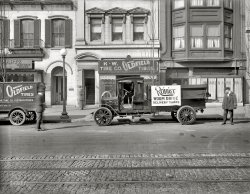
- Low Rider: 1942
- ... the rails on the pits are still 1940's era. We now service Long Island Railroad diesel engines. In the photo subject's day, the majority ... Posted by Dave - 08/30/2012 - 4:45pm -
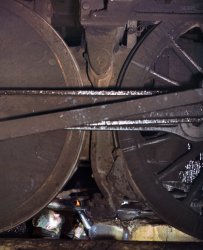
- Signs and Portents: 1910
- ... ashes across from Mr. and Mrs. Wilson's filling station on Long Island.
Big city to small town It's amazing to me how these ... Posted by Dave - 05/02/2014 - 12:13pm -
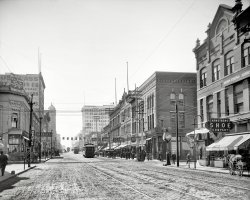
- Washington Flyer: 1921
- ... TRIES SUICIDE Here's a one-legged Herbert Bell from Long Island City (NYT, Jan. 22, 1914). Perhaps he found happiness as a bicycle ... Posted by Dave - 08/13/2013 - 4:09pm -
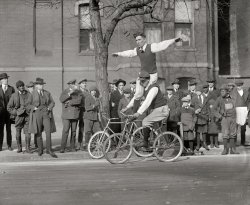
- Isadorable: 1921
- Long Beach, Long Island, New York, circa 1921. "Anna (Denzel) Duncan dancing." One of the ... Posted by Dave - 01/03/2016 - 1:11pm -
![Isadorable: 1921 Long Beach, Long Island, New York, circa 1921. "Anna (Denzel) Duncan dancing." One of the "Isadorables," as Isadora Duncan's German proteges were known. Glass transparency by Arnold Genthe. View full size.
Call the Swimsuit PoliceShe's showing leg all the way to the ground!
[Not to mention the other direction. - Dave]
Karate KidAll that's missing is a pier timber.
Aaaack! Something touched my foot!
Post processing.Looks like a bit of re-touching has been applied, thankfully.
Never Turn Your Back On the SurfBut sideways is okay if you have excellent peripheral vision.
Later. in the New Yorker...Tell me Thurber never saw that picture!
(The Gallery, Arnold Genthe, Dance)](https://www.shorpy.com/files/images/7a09879u1.thumbnail.jpg)
- Three Skyscrapers: 1912
- ... Maine coasts by day; going westward, the coasts by day, Long Island Sound by night. Time of passage 20 hours.
United Fruit ... Posted by Dave - 07/18/2012 - 6:59pm -
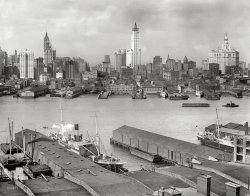
- Five-Tube Chassis: 1937
- ... a 5-tube Crosley superheterodyne receiver. We were on Long Island but at night that beast could pull in the race results from Bowie ... Posted by Dave - 05/05/2013 - 7:57am -
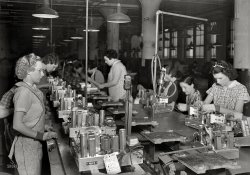
- When Frilly Met Paley: 1942
- ... 19, 1942. "William S. Paley, residence in Manhasset, Long Island. Mrs. Paley's bedroom, to bed." 5x7 acetate negative by ... Posted by Dave - 06/10/2021 - 12:57pm -
![When Frilly Met Paley: 1942 September 19, 1942. "William S. Paley, residence in Manhasset, Long Island. Mrs. Paley's bedroom, to bed." 5x7 acetate negative by Gottscho-Schleisner. View full size.
Dorothy Hearst Paley was sketched by Matisse, photographed by Cecil Beaton and Horst, listed as one of the world's best-dressed women and featured in Vogue and Harper's Bazaar. She decorated Kiluna Farm, the Paleys' 85-acre estate in Manhasset, with a saltwater pool and an indoor tennis court, lining the walls with their growing collection of Impressionist and Post-Impressionist paintings. Twenty-two servants looked after the house, gardens and greenhouse. (N.Y. Times)
Ah-CHOO!All those dust-catching frills and flounces make my nose tickle. I'm glad that style doesn't appeal to me, because I sure couldn't afford it, anyway.
I might have to adopt their style of nightstand, though. My current "tower'o'books" is apt to tip over and bury me one of these nights.
Here tooWell at least you have more cigarettes to allow a carbon monoxide slumber until the nicotine fit requires you to wake up and refuel.
Even the small desk at the foot of the bed has some smokes ... for children?
Next to lastHer successor, Mr. CBS's second and final wife, Barbara "Babe" Cushing Mortimer Paley, was quite the fashionista in her own right. The first Mrs. Paley's bedroom is ghastly ... but I could almost take it if not for that horror of a chandelier, complete with wonky tapers.
YikesBill Paley had a temper, and he could be crude; he once flashed Truman Capote to taunt Capote about his sexuality. I could see that sample-sized Governor Winthrop desk at the foot of the bed getting kicked into oblivion during a row.
AmbiguousShe had a very small secretary.
Foot of bedI don’t understand that thing at the foot of madame’s bed. People sometimes have benches in that place, but never anything like that. And it’s so tiny, like doll furniture. The whole room is so much like a strange dream or movie, but that particular piece is downright weird.
Truman CapoteInsinuated himself into the lives of Babe Paley, Cornelia Vanderbilt and Elizabeth Taylor and other high society women to such an extent that they trusted him with confidences they'd normally not share with anyone. The confidences were betrayed in an expose in Esquire beginning with the November, 1975 issue with the first installment of Answered Prayers. Babe was outraged and cut him off entirely and that was the beginning of the end of his career and ultimately his life.
[Babe had yet to enter the picture here. She married Bill in 1947. - Dave]
Simply Amazing"Less Is More", an expression evidently unknown here. Today, it's White, Grey, and Beige minimalist monotony void of warmth. There has to be a middle of the road though, and I sure would enjoy seeing it.
(The Gallery, Gottscho-Schleisner)](https://www.shorpy.com/files/images/SHORPY-5a08966u.thumbnail.jpg)
- In the Driver's Seat: 1915
- ... became the fastest woman with a speed of 111.5 mph on the Long Island Motor Parkway while driving a Pope Hummer on April 17, 1911. This ... Posted by Dave - 08/29/2012 - 2:12pm -
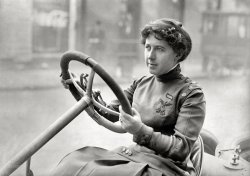
- Ice Cold: 1962
- ... homeTrash Compactor. I was in the appliance business on Long Island at that time and we started selling them. They outfitted our ... Posted by Dave - 09/04/2015 - 9:20am -
![Ice Cold: 1962 Circa 1962, another uncaptioned snap from the News Archive. Which way to the club meeting? 4x5 acetate negative. View full size.
The pennyWhen I was a first grader in '62 we would get a carton of cold milk for our lunches from the cafeteria vending machine for a penny. It was the only drink vending machine that I ever saw that took a penny. Today I try to imagine the job of emptying the change from that machine; why bother?
Who you gonna call?There seems to be some Ectoplasmic being gliding down the hallway.
Army brat?Is this another Columbus, Ga., photo? If so, I'm guessing that kid's dad is in the Army. Nearly every military dependent, including me and my sister, during that period had a similar jacket brought back from Japan or Korea by their U.S. Army dad.
Six Cent CokeWow, seen five cent Coke and a dime, but not six.
BottleneckIt's difficult for this current generation to understand the strength and durability of the 6 ounce coke bottle. Back in the early 1970s the Whirlpool Appliance Company released their first homeTrash Compactor. I was in the appliance business on Long Island at that time and we started selling them. They outfitted our display model with a lucite front panel allowing the customer to see the inner workings. We would demonstrate by throwing cans, bottles and general garbage in the unit and watch how the flat steel plate would come down and mangle anything in its path. One day one of my guys decided to put one of those Coke bottles in the compactor upright. That plate came down and when it reached the top of the bottle and kept pressing down on it the machine started to shake violently and I told them to turn it off before the thing exploded.
6 cent CokeI remember when the price went up from a nickel and inflation hit my dime a week allowance...
Extra HandBased on the extra digits this young man is exhibiting, my guess is he is attending a meeting of those afflicted by Polymelia.
Buddy, Can You Spare a Cent?I well remember the monumental inconvenience when Coke machines began demanding $0.06. All of a sudden, that stray penny you might have tossed into the sandbox to impress your friends took on genuine meaning.
Six cents worth....Look more closely and the six cents label is for the deposit on the bottle. I haven't any idea how they enforced it with nobody seemingly there to collect and refund the money.
[The cost of the Coke is 6¢. The sign instructs customers to deposit 1¢ first, then a nickel, dime or quarter. -tterrace]
Coke, Deposits, and GamblingI traveled extensively in the Deep South in the time of this photo, which I think was about the time our culture was rocked to its foundation by the shift from five cents to ten for vending machine Cokes.
Deposits were mostly of interest in gas stations and such, as Cokes consumed more formally were usually served fountain style. The deposit was always, in my experience, done on the honor system.
If you were taking your Coke on the road, you handed an employee your penny. If consuming it on the spot, you just burped and then slid the empty into the rack beside the machine. No one was monitoring anyone; it just worked back then.
The endless re-use of the incredibly durable bottle led to a universal game of chance. All bottles had the name of their first bottling plant cast on the bottom. After countless sales and refillings, the bottles were very widely distributed, to the point that it was unusual to find two the same in most encounters.
So, two people would purchase their Cokes and immediately invert them. Whoever had the most distant bottling plant marked paid the other the cost of a soda.
(The Gallery, News Photo Archive)](https://www.shorpy.com/files/images/SHORPY-637.thumbnail.jpg)
- It's a Small Train: 1951
- ... There are clubs that promote this hobby. Being from Long Island, there was an active club that had run days open to the public. ... Posted by Dave - 01/07/2015 - 8:00am -
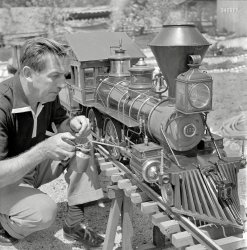
- The Nats: 1922
- ... years, Joe fronted a great bar and seafood restaurant on Long Island.
Big'un on the left I believe the big man on the far ... Posted by Dave - 09/03/2012 - 6:53pm -
![The Nats: 1922 "Washington Ball Club, 1922." View full size. National Photo glass negative.
Walter JohnsonThe great pitcher Walter Johnson played for the Senators for his entire 21-year career. I believe he is on the first row, fifth from the right. Johnson had twelve 20-win seasons, including ten in a row. Twice, he topped thirty wins. Johnson's record includes 110 shutouts, still a record. He is second in wins behind Cy Young, with 417.
[Walter is standing third from the left. He's also here. - Dave]
The NatsWashington -- First in War, First in Peace, and Last in the American League.
(Today that would be last in the National League East)
Nice Baseball PictureI love to study the great old baseball pictures.
Fun to see a very young Goose Goslin sitting front, center.
There's the legendary Walter Johnson, content to be an afterthought in the back.
I'm trying to figure out the Big 'Un far left. Ballplayers were smallish then, and that huge man just stands out. I'm guessing he is lefty Harry Courtney, but he sure looks bigger than 6'4", given that Walter Johnson is listed at a generous 6'1".
[Harry Courtney (top three pics below) is on the right; Walter Johnson (fourth pic) is third from left. - Dave]
Bad Season69 wins, 85 losses.
Not so hot in 1922....butdidn't they win the AL pennant in 1925 and played in the Series vs. the NY Giants in 1925? (The year Babe Ruth had the "big tummyache.") I think they won the pennant again in 1933, with Bucky Harris the Boy Wonder and Joe Judge (?). In later years, Joe fronted a great bar and seafood restaurant on Long Island.
Big'un on the left I believe the big man on the far left is Walter "Slim" McGrew from Yoakum, Texas. While he was big his career was short (three years and 30 innings pitched) all with the 'Nats.
Slim McGrewThat is indeed Walter "Slim" McGrew on the far left. He sure McGrew alright; he's the tallest player of his time. He was 6'-7½". Decent minor league pitcher. Didn't get much of a chance in the big leagues. He looks so out-of-place in this picture. They didn't make many 1920's ballplayers like him. Seeing him in this assemblage reminds me of when the great fireballer Herman "The Green Monster" Munster pitched briefly (part of one episode) for the Dodgers.
They had to wait two yearsThey won the pennant and World Series in 1924, with the Big Train going 23-7 and winning the MVP. They won the pennant in '25 as well, but lost the series in seven games with an exhausted Johnson left on the hill too long.
(The Gallery, D.C., Natl Photo, Sports)](https://www.shorpy.com/files/images/30252u.thumbnail.jpg)
- Leaf Smoke: 1940
- ... - and setting them afire - was a common fall exercise on Long Island. Well into the 1950s. Yes, it was a sweet smell.
That should ... Posted by Dave - 12/28/2007 - 10:04pm -
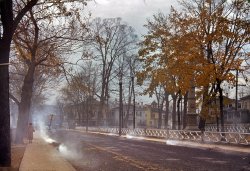
- Hollywood Hopefuls II: 1925
- ... will be housed in the Paramount Eastern Studio at Astoria, Long Island." View full size. National Photo Company Collection glass ... Posted by Dave - 09/09/2011 - 6:22pm -
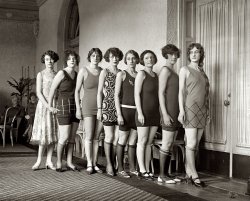
- Jumping-Off Point: 1923
- ... NY. It was one of the few places on an ocean surrounded Long Island that you could find calm fresh water to swim in. We too had huge ... Posted by Dave - 07/23/2012 - 6:43pm -
![Jumping-Off Point: 1923 Washington, D.C., 1923. "Opening of bathing beach." A diving platform in the Potomac Tidal Basin. National Photo Co. glass negative. View full size.
Busy LifeguardConsidering the haphazard (and amateurish) diving that's going on, I suspect the LG in the boat is kept plenty busy. Note the man to the right near the bottom about to jump on top of the woman just below him.
Tidal wavesWe were in D.C. last week and on Wednesday morning visited the Jefferson Memorial when the winds really kicked up, we were leaning against the airs, and the chop in the Tidal Basin was at least a couple of feet high.
Looking out at the waves made me recall the many Tidal Basin bathing beach photos posted here on Shorpy.
Looks like a blast!Too bad the lawyers made this kind of fun an impossibility in today's world.
Synchronized DivingAre the men at the top right leaping off separately, but at the same time? Or is one holding the other in front of him?
[They're side by side. - Dave]
Segregated?Was this a segregated facility? Was there a separate beach or diving platform for African-Americans?
[There were two municipal bathing beaches at the Tidal Basin. The white one, on the southeastern side, opened in 1918 and was enlarged in 1921. The "colored bathing beach," on the west shore of the Tidal Basin, was dismantled in 1925 (which may have been the same year it was built; the news accounts are hard to follow, for me at least). Shortly after that, white bathing beach was eliminated. All amid much controversy. There were plans for a "colored bathing beach" on the Anacostia River, evidently so the white beach could be reopened, but that doesn't seem to have panned out. More info here. - Dave]
Deja vu This could be a scene at any freshwater lake in America, 1950's summertime. The background looks much like the commercial changing rooms at Lake Ronkonkoma, NY. It was one of the few places on an ocean surrounded Long Island that you could find calm fresh water to swim in. We too had huge pump slicked slides and dive rafts, though not anywhere that tall!
(The Gallery, D.C., Natl Photo, Sports, Swimming)](https://www.shorpy.com/files/images/08630u_0.thumbnail.jpg)
- Buy More War Bonds: 1943
- ... worked for Coca Cola, got me a summer job working at their Long Island City, NY bottling plant.
At first, I was put to work stacking ... Posted by Dave - 09/19/2013 - 10:12am -
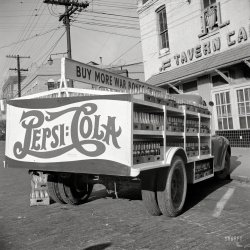
- The Chamber: 195x
- ... H-model submarine, probably undergoing testing trials in Long Island Sound.
Powered by several hundred hamsters, or in the more ... Posted by Dave - 02/19/2017 - 1:21pm -
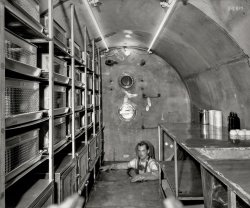
- Ladies' Furnishings: 1951
- May 17, 1951. "John Wanamaker, Great Neck, Long Island. Staircase I." Two departments of this New York department store; ... Posted by Dave - 01/22/2015 - 1:45pm -
![Ladies' Furnishings: 1951 May 17, 1951. "John Wanamaker, Great Neck, Long Island. Staircase I." Two departments of this New York department store; we wonder if Alice and Trixie ever ventured out this far. 4x5 negative by Gottscho-Schleisner. View full size.
Hoity-toity!Somehow I think John Wanamaker would have been out of Ralph Kramden's price range, and Ed Norton's, too.
OK, OK,Why is the handrail wrapped in cloth?
[To keep it from getting dinged or scratched. The store is brand-new. -Dave]
Where is the night watchman?Comfy looking man cave, football-watching furniture, pre-opening day for the store given the paper wrapping on the handrails and void of human activity, or maybe it's just "shorply" after 6 AM.
Re: Hoity toityHaving grown up nearby, even if Alice & Trixie had had the means, they probably wouldn't have made it across the parking lot before being caught by the locals -- no doubt by a group of "ladies who lunch" that could spot someone from the city and cut them dead at 100 yards...
In regards to the stairway treatment; the panels on the railing closely resemble some sheers we had in our living room -- "flameproof" Fiberglas fabric. Lasted forever, but don't EVER put them in the wash -- worse than itching powder.
Before self-serviceThis was a very elegant, plush and classy environment in which to shop without the frantic pace and chaos of lining up at checkout counters, when a salesperson would leisurely show you what was available, find your size, attend to your needs and check with the stockroom to see if they had exactly what you wanted. Sometimes there was a live piano player on the main floor and the carpeting kept the noise level soft, peaceful and quiet. I am curious about the item that looks like a miniature female mannequin in a hooded raincoat on the extreme left counter of this picture near the hats and accessories. I bet that little novelty would be a collectible today and I think it would have been a pleasure to shop here.
[That's a nice evocation of the old-school department store. There were of course plenty of self-service retail establishments going back to the early years of the 20th century, and I suspect Wanamaker's, with its racks of suiting and shelves of shirts, had the about same degree of self-service as its modern analogues. What it isn't is a high-volume discount chain like Walmart or Target. - Dave]
Yes Dave, you are correct. One store that is old and probably out of business stands out in my mind as basically just racks and racks of clothing in huge warehouse-like buildings and that would be the old Robert Hall stores, but they did have bargains in apparel. I don't think they sold much other than suits, coats, jackets and things of that ilk. It really was "off the rack" merchandise in every sense of the word.
The day after the store openedAnd less than four years before it closed. Story here.
Mini mannequin I have a very dim memory of such mannequins being used to display miniature foundation garments in the 1950s, presumably in the interests of modesty.
Childhood memories.My mother used to shop at this store. Those elevators were manned by uniformed operators ready to transport you to any of the three floors. After Wanamaker left it became Gertz for many years until the seventies.
Hot Copper BottomsLooking down the stairs, to the right, is a sales gondola of RevereWare copper bottom saucepans with lids. I wish we could read the pricing panel at the top of the gondola. My grandmother prized her RevereWare and the copper was always bright and polished. I still use much of her collection, over 60 years old.
(The Gallery, Gottscho-Schleisner, Stores & Markets)](https://www.shorpy.com/files/images/SHORPY-5a20480u.thumbnail.jpg)























